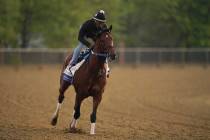Kentucky Derby picture begins to clear, but betting options limited
I’m torn about devoting so many words to a race that is likely to be mainly fenced off from Nevada horseplayers and unsuspecting visitors in just over two weeks. But the Kentucky Derby is, after all, the Kentucky Derby, and it doesn’t feel right to ignore it, either.
Regular horseplayers and other serious bettors like the race for its swing-for-the fences wagering opportunities and the bragging rights that come with a big score in the world’s most famous horse race. I’m not worried about them, as they will find a way to bet despite the contractual impasse between the Nevada Pari-Mutuel Association and Churchill Downs Inc., which is in its 18th month.
Casual fans, meanwhile, are often caught up in the storylines, celebrities and strange traditions of an event that seems to have been teleported into the modern world. They’ll still be able to put their $5 or $10 show bets on long shots that remind them of a long-lost relative or pet, so they should be OK, too.
I, on the other hand, have no intention of reliving “Derby Lite” from last year, when most Las Vegas racebooks limited wagering to win, place and show, offered no betting on the Churchill Downs undercard and served up no horizontal or vertical wagering except for exactas and trifectas, both of which were capped at ridiculously low levels.
If the impasse is still in place on May 1, I may just take a drive to Kingman to dump some money into Arizona’s tax coffers at the nearest simulcast facility.
The good news is that means I have every reason to continue to comb through the Derby crumbs like a hungry chicken and offer you the most succinct summary I can.
I promised last week that we would know more this week than last, and indeed we do. Below are a few nuggets that will help you get your head into the race ahead of next week’s column, when we’ll dive deeper into handicapping and outline betting strategies.
First, we offer a chart comparing the highest ratings bestowed by various speed figure services for the top 20 contenders for this year’s Run for the Roses, a 1¼-mile race for 3-year-olds. I don’t recommend betting by speed figures alone, but the variances between how different services view certain prep races can be illuminating.
As for what we’ve learned since last week, consider these conversation starters:
— The bottom end of the field is still being finalized, but Essential Quality will be the posttime favorite, barring some great misfortune descending on his stall. The 2-year-old Eclipse champion has yet to lose in five starts, including the Breeders’ Cup Juvenile, and is likely to close at 5-2 or thereabouts.
After that it gets a little murky. Florida Derby winner Known Agenda could end up as the second choice, maybe as low as 4-1, with Rock Your World right in there around 5-1. Concert Tour, Highly Motivated, Hot Rod Charlie, Medina Spirit and Super Stock also seem likely to draw considerable support.
— It’s not really possible to do a detailed pace analysis at this point, but at first blush it looks like the early fractions will be quick, with Caddo River, Concert Tour, Hot Rod Charlie, Medina Spirit, Midnight Bourbon and Soup and Sandwich among those who could be on or just off the lead.
— If a speed duel occurs, you’ll want to look for horses that can finish well, including some that you might have tossed if the pace was projected to be slow. Courtesy of VSIN’s Ron Flatter, I can tell you that four horses have run the final 3 furlongs of their career-best races in under 37 seconds — Essential Quality, Highly Motivated, Known Agenda and Rombauer. But there are some other interesting closers in the field who will be long odds and might be worth including on vertical or horizontal wagers (if you are able to make any).
Mike Brunker’s horse racing column appears Fridays. He can be reached at mbrunker@reviewjournal.com or 702-383-4656. Follow @mike_brunker on Twitter.























